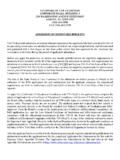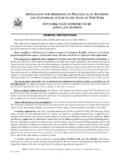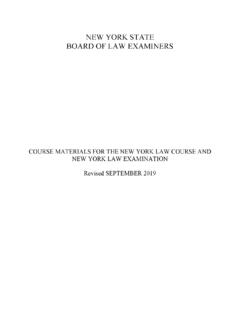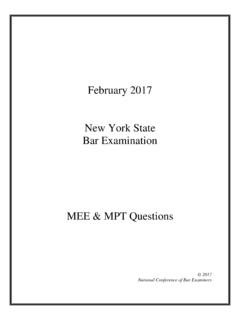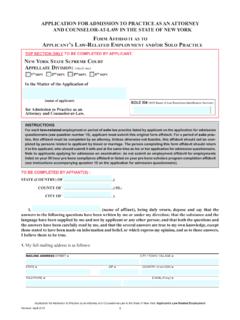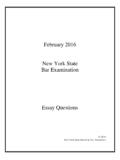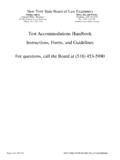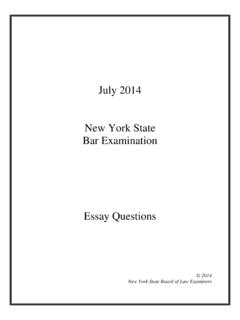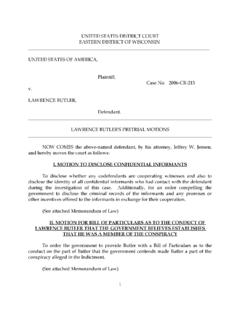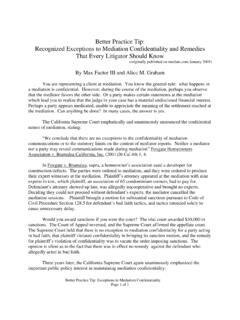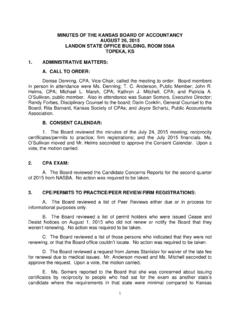Transcription of February 2015 New York State Bar Examination
1 February 2015 New york State Bar Examination Essay Questions 2015 New york State Board of Law Examiners 1 QUESTION 1 In 1995, Walt, a widower, executed a will prepared by his lawyer, Len, which contained the following dispositive provisions: 1. I give and devise my residence to my daughter, Amy. 2. I give and bequeath my 100 shares of C Corp. to my son, Ben. 3. I give and bequeath $100,000 to my son, Cal. 4. I give and bequeath $100,000 to the American Red Cross. 5. I give, devise and bequeath all of the rest, residue and remainder of my estate to my grandson, Dave. Walt signed the will at Len s office, and at Walt s request, Len and Walt s son, Ben, signed as witnesses in the presence of Walt and each other after Walt acknowledged that the document was his will.
2 In 2000, Walt duly executed a new will which expressly revoked any and all wills previously made by him. In 2001, Walt decided that he did not like the terms of the 2000 will and physically destroyed it by his own hand. Walt died last year, survived by Amy, Ben, Cal, and Dave. Dave is Walt s only grandson and is the son of Walt s deceased son, Ed. The 1995 will has been admitted to probate over the objections of Cal that the 1995 will had not been properly executed and that, in any event, it had been revoked. Walt s residence has been valued at $300,000, and his 100 shares of C Corp. have been valued at $200,000. After payment of all debts, expenses and taxes, the net estate, including the residence and the C Corp. shares, is $600,000. (1) (a) Was the 1995 will properly executed?
3 (b) Assuming the 1995 will was properly executed, was it properly admitted to probate? (2) Assuming the 1995 will was properly admitted to probate, what part, if any, of the net estate should be distributed to: (a) Amy? (b) Ben? (c) Cal? (d) The American Red Cross? (e) Dave? 2 QUESTION 2 Dell was driving his car at night on an unlighted winding country road when, without slowing down, he struck a pedestrian who was walking on the shoulder of the road adjacent to a field. The posted speed limit for the road was 30 miles per hour. Officer arrived at the scene of the accident 15 minutes later and found Dell sitting in his car in the field. Without giving Dell any Miranda warnings, Officer asked him why his car was in the field, and Dell said that he was driving down the road and his car hit something.
4 Officer noticed that Dell s eyes were glassy, his speech was slurred, and his breath had a strong odor of alcohol. When Dell exited the car at Officer s direction, he could not stand without holding onto the car. Dell refused Officer s request that he take a breath test to determine the percentage of alcohol in his blood. An ambulance arrived, and the pedestrian was pronounced dead. Officer arrested Dell and took him to the police station. Officer then appeared before a judge who, based upon the above facts, issued an order for a chemical test of Dell s blood. The blood test was administered and showed Dell s blood alcohol level to be substantially above the legal limit for driving while intoxicated. Dell was indicted for the crime of manslaughter in the second degree.
5 A person is guilty of manslaughter in the second degree when he recklessly causes the death of another person. Prior to the trial, Dell moved to suppress the results of the blood test on the ground that it was improperly authorized. He also moved to suppress his statement -that he was driving down the road and his car hit something - because he was not given Miranda warnings. The court (a) granted Dell s motion to suppress the results of the blood test and (b) denied Dell s motion to suppress his statement. Uncontroverted testimony as to all of the above facts, except the blood test results, was received at the trial. In addition, an expert testified, based on his observations and measurements at the scene, that Dell s car was travelling in excess of 55 miles per hour when it left the road and struck the pedestrian.
6 After both sides rested, Dell made a motion (1) to dismiss the indictment on the grounds that the evidence was legally insufficient to establish the crime of manslaughter in the second degree, and (2) in the alternative, to submit to the jury a charge of criminally negligent homicide as a lesser-included offense. A person is guilty of criminally negligent homicide when, with criminal negligence, he causes the death of another person. The court denied the motion in both respects. Dell was convicted of manslaughter in the second degree. (1) Was the court correct in its pre-trial determinations: (a) to suppress the results of the blood test? (b) not to suppress Dell s statement? 3 (2) Was the evidence presented at trial legally sufficient to support the conviction of manslaughter in the second degree?
7 (3) Was the court correct in denying Dell s request to charge the lesser- included offense of criminally negligent homicide? QUESTION 3 In 2000, Len, Jane and Charley, licensed architects, formed a New york professional service corporation (PC). PC designs commercial buildings in the New york City area and specializes in designing green buildings that utilize environmentally sustainable building materials. PC s only office is located in New york City. In 2013, PC entered into a written contract with Developer, a commercial developer, for the design of an office building. Len was the only PC shareholder involved in creating the design of the building. PC timely completed the design according to the parties contract, which did not contain any provisions about damages in the event of a breach.
8 Developer thereafter commenced construction of the building pursuant to PC s design. Mid-way through construction, extensive mold was discovered behind the building walls. It was determined that the cause of the mold was excessive moisture trapped behind the drywall caused by a design defect. Completion of construction of the building was delayed nine months while the mold was remediated and certain design changes were made. Developer claims that, due to the delay, it has lost rental income which would have produced a profit of $250,000. Although Developer did not have any tenants under lease, it claims that, had the building been completed on time, it could have rented all of its space earlier based upon the current rental market and comparable properties it owns in the same locale.
9 PC was not aware of Developer s anticipated date for completion of the building, which was not part of its contract with Developer, and it had no knowledge of Developer s plans for rental of the building. Developer thereafter commenced a breach of contract action against PC seeking to recover its lost profits as consequential damages. In addition to PC, Developer named Len, Jane and Charley, individually, as defendants in the action, and duly served each of them with the summons and complaint. In a separate cause of action sounding in negligence, Developer alleges that Len, Jane and Charley, as shareholders of PC, are personally liable for PC s negligence. 4 In 2008, PC had hired Sam as its exclusive sales and marketing director. As a condition of his employment, Sam was required to sign a non-competition agreement, which stated, inter alia, that for a period of one year after Sam left PC s employ, he could not: directly or indirectly own, operate, control, be employed by or consult for, participate in, render services for, or be connected in any manner with the ownership, management, operation or control of any architectural firm or other business engaged in the design or construction of green buildings anywhere in New york State .
10 PC trained Sam extensively in its confidential design techniques and its pricing methodologies. It also provided Sam with a generous expense account which enabled Sam to promote PC s designs. Last week, Sam contacted Attorney seeking legal advice concerning the enforceability of the non-competition agreement. Sam would like to quit his position with PC and accept a similar sales position with Central Architectural, an architectural firm located in Syracuse, approximately 250 miles from the New york City area. During the client interview, Sam told Attorney that he had over 20 years of experience in sales and marketing in various industries. He conceded that PC had devoted significant time and money creating its goodwill in the green building market, which enabled Sam to expand PC s customer base in that market.
